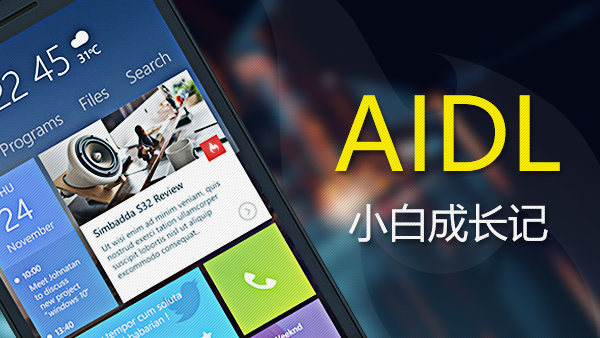3.0 新建一个项目,Notificationtest,目录如下:

2019-02-21_165013.png
备注:为什么不把源代码上传到Gittub?因为Android编程的尿性,更新换代很快,今天能运行的代码,明天不一定能跑得起来(而且配置文件超多)。所以习惯性展示目录和代码,可以避免某些参考时可能存在的版本兼容问题。
4.0 布局文件中就一个控件:
<?xml version="1.0" encoding="utf-8"?><android.support.constraint.ConstraintLayout xmlns:android="http://schemas.android.com/apk/res/android" xmlns:app="http://schemas.android.com/apk/res-auto" xmlns:tools="http://schemas.android.com/tools" android:layout_width="match_parent" android:layout_height="match_parent" tools:context=".MainActivity"> <Button android:id="@+id/send_notice" android:layout_width="wrap_content" android:layout_height="wrap_content" android:text="发送通知" app:layout_constraintBottom_toBottomOf="parent" app:layout_constraintLeft_toLeftOf="parent" app:layout_constraintRight_toRightOf="parent" app:layout_constraintTop_toTopOf="parent" app:layout_constraintVertical_bias="0.05" /></android.support.constraint.ConstraintLayout>
5.0 划线的重点来了,需要解决新版本的兼容问题
由于升级到Android O(安卓欧,不是安卓零)版本后,一些方法被弃用,而且Android O引入了通知渠道(Notification Channels),以提供统一的系统来帮助用户管理通知,如果是针对 android O 为目标平台时,必须实现一个或者多个通知渠道(就是要new NotificationChannel()),以向用户显示通知。比如聊天软件,为每个聊天组设置一个通知渠道,指定特定声音、灯光等配置。
6.0 先解决状态栏通知显示需要干什么,再解决考虑到Android O版本还需要做什么。
6.1 通知显示需要3步走:
1.第1步:获取状态通知栏管理:
2.第2步:实例化通知栏构造器
NotificationCompat.Builder3第3步:对
Builder进行配置:
(第3步和第2步之间本来还有1步的,但是不是必要,放下一章讲解——通知栏点击事件处理)
6.1.1 状态栏通知的管理类 NotificationManager,负责发通知、清除通知等操作。
注意:NotificationManager是一个系统Service,
所以必须通过 getSystemService (NOTIFICATION_SERVICE)方法来获取。
6.1.2 实例化通知栏构造器通过声明Notification类
一个 Notification 的必要属性有三项,如果不设置则在运行时会抛出异常:
小图标,通过
setSmallIcon()方法设置标题,通过
setContentTitle()方法设置内容,通过
setContentText()方法设置
除了这3种还有:
setWhen()通知产生的时间。会在通知信息里显示,通常是系统获取到的时间:setWhen( System.currentTimeMillis() )setLargeIcon()设置通知大ICONsetPriority设置通知优先级setOngoing(false)设置它为一个正在进行的通知。他们通常是用来表示一个后台任务,用户积极参与(如播放音乐)或以某种方式正在等待,因此占用设备(如一个文件下载,同步操作,主动网络连接)setNumber( )设置通知集合的数量setStyle( )设置setAutoCancel(true)设置这个标志当用户单击面板就可以让通知将自动取消(手机QQ就是设置成false,所以你在通知栏总是取消不掉它)setTicker( )设置通知首次出现在通知栏,带上升动画效果的setContentIntent(getDefalutIntent(Notification.FLAG_AUTO_CANCEL))设置设置通知栏点击意图setDefaults(int defualts)为了精简学习难度,Notification的通知效果知识点本章不写。(通过setDefaults(int defualts)方法来设置。一旦设置了Default效果,自定义的效果就会失效。Default效果可以相互组合)6.1.3 第3步,只需要调用
NotificationManager的notify()方法就可以让通知显示出来。
notify()方法接收2个参数:
第一个参数是
id,保证每个通知的id都是不一样的。第二个参数是指
Notification对象,将第二步建好的Notification对象传入即可。这样显示一个通知就可以写成:
NotificationManager manager = (NotificationManager) getSystemService(NOTIFICATION_SERVICE); Notification notification = null; ... manager.notify(1, notification);
OK,理论讲完,继续往下走
7.0 综合上面理论知识,下面MainActivity.java中的代码,看懂就没什么大问题了。
package com.example.notificationtest;import android.app.Notification;import android.app.NotificationChannel;import android.app.NotificationManager;import android.graphics.BitmapFactory;import android.os.Build;import android.support.annotation.RequiresApi;import android.support.v4.app.NotificationCompat;import android.support.v7.app.AppCompatActivity;import android.os.Bundle;import android.view.View;import android.widget.Button;public class MainActivity extends AppCompatActivity implements View.OnClickListener { private String id = "channel_001"; private String name = "name"; @Override
protected void onCreate(Bundle savedInstanceState) { super.onCreate(savedInstanceState);
setContentView(R.layout.activity_main);
Button sendNotice = (Button) findViewById(R.id.send_notice);
sendNotice.setOnClickListener(this);
} @RequiresApi(api =26) @Override
public void onClick(View v) { switch (v.getId()) { case R.id.send_notice: //第一步:获取状态通知栏管理:
NotificationManager manager =
(NotificationManager) getSystemService(NOTIFICATION_SERVICE);
Notification notification = null; //第二步:实例化通知栏构造器NotificationCompat.Builder:
if (Build.VERSION.SDK_INT >= Build.VERSION_CODES.O) {//判断API
NotificationChannel mChannel = new NotificationChannel(id, name,
NotificationManager.IMPORTANCE_LOW);
manager.createNotificationChannel(mChannel);
notification = new NotificationCompat.Builder(this, id)
.setContentTitle("这是一个内容标题")//设置通知栏标题
.setContentText("这是一个内容文本") //设置通知栏显示内容
.setWhen(System.currentTimeMillis())//通知产生的时间。
// 会在通知信息里显示,通常是系统获取到的时间
.setSmallIcon(R.mipmap.ic_launcher)//设置通知小ICON
.setLargeIcon(BitmapFactory.decodeResource(getResources()
, R.mipmap.ic_launcher))//设置通知大ICON
.build();
} else {
NotificationCompat.Builder notificationBuilder = new NotificationCompat.Builder(this, id)
.setContentTitle("这是一个内容标题")
.setContentText("这是一个内容文本")
.setSmallIcon(R.mipmap.ic_launcher)
.setLargeIcon(BitmapFactory.decodeResource(getResources()
, R.mipmap.ic_launcher));// .setOngoing(true);
notification = notificationBuilder.build();
} //第三步:对Builder进行配置:
manager.notify(1, notification); break; default: break;
}
}
}需要注意的两个方面:
用的实现
implements关键字实现监控的接口,这是因为在经常用的内部类中,用NotificationCompat.Builder(Context context, String channelId)报错……网上代码基本都是用
NotificationCompat.Builder(Context context)方法,但这个方法已经弃用,最新版本NotificationCompat.Builder(Context context, String channelId),channelId在一开始就随便申明一个就好……关于解决
Android O兼容性问题,看9.0
8.0 解决Android O版本兼容性问题(好吧,本来想放在6.2的):在Android 8版本及以上按网上大部分的代码来写,是不会显示状态栏通知的。
需要用到如上代码中if语句来处理,记得声明@RequiresApi(api =26)。
下面开始解释下这个逻辑,把上面MainActivity.java中if语句代码抄下来如下所示:
//如果当前Android的版本相比Android O,一样或者版本更高,就建通知渠道(Notification Channels )
if (Build.VERSION.SDK_INT >= Build.VERSION_CODES.O) {//判断API
//1.0 建渠道
NotificationChannel mChannel = new NotificationChannel(id, name,
NotificationManager.IMPORTANCE_LOW); //2.0 把通知渠道通过createNotificationChannel( )方法给-
// -状态栏通知的管理类 NotificationManager
manager.createNotificationChannel(mChannel); //3.0 Notification这时候可以正常工作了
notification = new NotificationCompat.Builder(this, id)
.setContentTitle("这是一个内容标题")//设置通知栏标题
.setContentText("这是一个内容文本") //设置通知栏显示内容
.setWhen(System.currentTimeMillis())//通知产生的时间。
// 会在通知信息里显示,通常是系统获取到的时间
.setSmallIcon(R.mipmap.ic_launcher)//设置通知小ICON
.setLargeIcon(BitmapFactory.decodeResource(getResources()
, R.mipmap.ic_launcher))//设置通知大ICON
.build();
} else { //如果当前Android的版本比Android O(API 26)版本要低
//直接开始上面的3.0步骤——Notification这时候就可以正常工作了
NotificationCompat.Builder notificationBuilder = new NotificationCompat.Builder(this, id)
.setContentTitle("这是一个内容标题")
.setContentText("这是一个内容文本")
.setSmallIcon(R.mipmap.ic_launcher)
.setLargeIcon(BitmapFactory.decodeResource(getResources()
, R.mipmap.ic_launcher));// .setOngoing(true);
notification = notificationBuilder.build(); //为什么if语句里面两个3.0不一样
// notification =
// new NotificationCompat.Builder(this, id)
// .setContentTitle("这是一个内容标题")
// .setContentText("这是一个内容文本")
// .setSmallIcon(R.mipmap.ic_launcher)
// .setLargeIcon(BitmapFactory.decodeResource(getResources()
// , R.mipmap.ic_launcher)).build();
//这几行代码就一样了。
}如上。
9.0 执行项目(如果你的手机系统版本是Android 8.0.0版本及以上,建议用真机测试,真机测试更自信):
现在Android 9.0.0(API 28)模拟器运行:

2019-02-21_195725.png
点击“发送通知”按钮,最上方标题栏出现一个小白点:

2019-02-21_195731.png
下拉状态栏,查看:

2019-02-21_195737.png
接下来在Android 7.0.0(API 24)模拟器运行:

2019-02-21_195831.png
点击“发送通知”按钮,最上方标题栏出现一个小白点:

2019-02-21_195837.png
下拉状态栏,查看:

2019-02-21_195844.png
作者:我睡醒刚刚
链接:https://www.jianshu.com/p/556acaf2195c

 随时随地看视频
随时随地看视频




